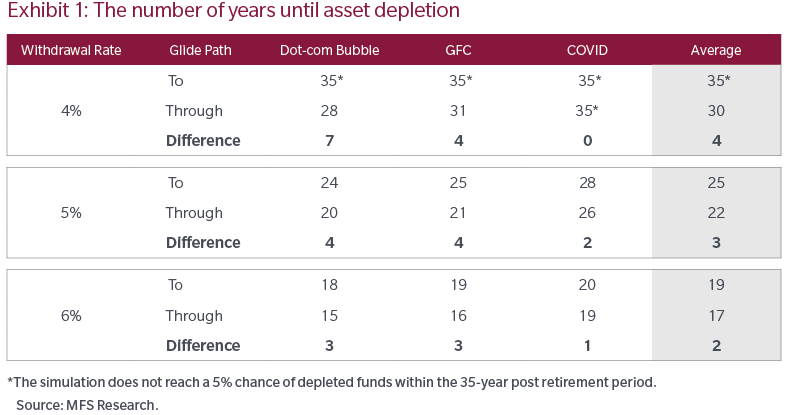
How May Glide Path Design Impact Outcomes in Retirement?
As retirees shift from saving to spending, the right asset allocation strategy can make a significant difference in financial security. This white paper explores the trade-offs between aggressive and conservative glide path designs during the decumulation phase.
Authors
Erich Shigley, CFA
Portfolio Manager
Derek Beane, CFA
Institutional Portfolio Manager
Stephanie Okpoebo
Quantitative Research Analyst
In brief
- We explore the trade-offs between aggressive and conservative asset allocation strategies during the decumulation phase of the retirement journey.
- By adopting a more conservative allocation strategy in retirement, we believe investors can still support lifestyle needs while aiming to mitigate the impact of worst case scenarios.
- In our analysis, utilizing a more conservative allocation does not increase the chances of outliving one’s assets. However, it can meaningfully extend asset longevity when confronted with a market crisis.
- We suggest investors are better served by a conservative retirement allocation that prioritizes long-term durability.
As a target-date manager, our team thinks a lot about appropriate asset allocation during both the accumulation and decumulation phases of the retirement savings journey. In this paper, we focus on the decumulation phase and explore how glide path structure can impact outcomes in retirement. As with most choices in life, there will be tradeoffs, which we will explore. As one might expect, a key piece of this analysis will center around the ability of different glide paths to support the investor’s withdrawals long into the future, under various market conditions.
After spending a career building up retirement savings, assets are drawn down in retirement to support one’s lifestyle. Asset longevity — avoiding the dreaded scenario of depleting your assets at a time when you’re still likely to need them — is crucial. Is having a more aggressive equity allocation the key to success and asset longevity? Or is it better to go forward in retirement with a more cautious equity allocation, reducing the impact of a potential market crisis on your portfolio?
We explore these questions and more in the analysis that follows. As this research focuses exclusively on the decumulation period, we assume a given portfolio value at retirement regardless of the glide path followed to that point. Two different retirement glide path strategies are compared:1
- A through-based approach that has an elevated equity weight at retirement and de-risks steadily during the years that follow.
- A to-based approach that enters retirement with a lower equity weight, which remains fixed going forward.
Our simulation analysis compares these glide paths using two distinct types of simulations:2
- Crisis Simulations: This method puts the portfolios through a period of significant market decline, or “drawdown,” at the beginning of retirement. After this initial crisis period, we continue the simulation by randomly drawing asset class returns and inflation from historical data.
- Normal Simulations: In this approach, we do not subject the portfolios to a drawdown at the beginning of retirement. Asset class returns and inflation rates are drawn randomly from history. This method is commonly used to estimate how a glide path might perform under typical or average market conditions.
In both types of simulations, we explore the probabilities of depleting assets by certain ages, under various withdrawal rate assumptions.
Crisis Simulations
The crisis simulations focus on the impact of experiencing a downside scenario early in retirement. Experiencing a market drawdown at this point in the journey can create significantly more hardship than experiencing one earlier in a career given ongoing investor withdrawals and a shorter investment horizon over which to recover ground. Which glide path fares better? Does a more aggressive asset allocation better enable one to recover after the crisis, or does it dig a hole too deep to recover from? Does a conservative glide path preserve more value in a crisis but struggle to grow sufficiently thereafter? Clearly a crisis scenario will reduce asset longevity for both glide paths, but which one weathers the storm better?
In the table below, we subject each glide path to three historical crisis scenarios, which are then followed by a normal return environment. We calculate the number of years at which there is a meaningful chance of asset depletion.3 As shown, in every case, the more conservative to-based approach provides a material number of extra years before reaching the chance of asset depletion.

The lessons here are pretty simple. The more aggressive through-based glide path is considerably more vulnerable to a crisis event early in retirement. It suffers a larger initial drawdown, of course, but its higher equity weight is not sufficient to make up ground post crisis. As a result, the expected life of the assets is materially shorter in comparison to the more conservative to-based approach, which experiences a smaller initial drawdown.
Another way to visualize this is to graph the probability of asset depletion over time. Below we illustrate the chances of reaching a zero balance for each glide path, assuming a GFC-type crisis occurs at retirement (followed by normal returns thereafter) and a 5% withdrawal rate. As time progresses, the to-based glide path offers a materially lower chance of running out of money. For example, at year 25 post-retirement, the probabilities of asset depletion are less than 5% for the to-based glide path and nearly 20% for the through-based glide path. That is a big difference!

Normal Simulations
At this point, it would be fair for the reader to accuse us of cherry picking. Maybe imposing a crisis event on a portfolio around the time of retirement is a bit extreme. Under more normal circumstances, perhaps a more aggressive glide path, with its higher equity weight and higher returns, is the better choice for asset longevity.
To investigate this, we conducted the same analysis in the normal return simulation environment, described above. Rather than subjecting the portfolios to an early crisis, here the portfolios are subjected to the normal ebbs and flows of the market. The graph below illustrates the chances of reaching a zero balance through time for each glide path.

The simple takeaway here is that the conservative to-based approach is just as likely as the more aggressive approach to support over 35 years of withdrawals. Being more aggressive does not materially impact asset longevity. The more conservative asset mix is plenty capable of keeping up with inflation-adjusted withdrawals.
Key Considerations
We understand, if all goes well, both glide paths are likely to support the investor’s lifestyle to the end, with some extra left over. And we grant that the more aggressive approach is likely to have a little bit more left over — roughly on the order of 10%, according to our analysis.
But consider this: When an investor opts for an asset allocation strategy that increases their risk exposure, they aren't just engaging in a hypothetical exercise. Rather, they are actively entrusting the chosen approach to meet their financial security, their retirement dreams and their peace of mind. Is the lure of a slightly higher average outcome worth meaningfully increasing the risk of running out of money when you need it most?
We believe the answer is a resounding “no.” An asset allocation strategy which creates a materially higher chance of running out of money does not justify a slightly higher average outcome. The goal of investing should be not only to grow wealth but to protect it against the uncertainties of the future. By adopting a more conservative allocation strategy in retirement, investors can still pursue meaningful growth while maintaining a safety net that guards against the worst-case scenarios.
Conclusion
In our view, the decumulation phase is not the time to err on the aggressive side of asset allocation. As shown, a more conservative to-based approach can materially extend asset longevity when confronted with a crisis, while at the same time not sacrificing longevity under more normal circumstances. As we see it, the only advantage of the through-based glide path is the ability to potentially leave behind slightly greater assets after death. But we don’t feel this advantage is worth materially increasing your risk and your chances of outliving your assets.
We suggest investors are better served by a glide path that prioritizes long-term durability over chasing modestly higher returns. After all, the true measure of successful investing isn't just about the potential size of your account balance at the end of your life; it's about the quality of life those assets can guarantee along the way.
Ensuring you are on a stable path into retirement involves assessing your goals and objectives for retirement. We believe it’s a good idea to review your plan. That way, you can take comfort in knowing you’re managing the retirement assets you’ve saved over your career in the most thoughtful way possible.
Endnotes
1 Methodology: 35-year retirement horizon. To-based glide path maintains a static 29% equity weight (23% global, 6% Canadian) and a 71% fixed income weight (63% Canadian, 8% global). Through-based glide path begins with a 50% equity weight (10% Canadian, 40% global) and a 50% fixed income weight (44% Canadian, 6% global), with exposure decreasing to 40% equity (8% Canadian, 32% global) and 60% fixed income (53% Canadian, 7% global) five years after retirement, 35% equity (7% Canadian, 28% global) and a 65% fixed income weight (58% Canadian, 7% global) 10 years after retirement, 30% equity (6% Canadian, 24% global) and 70% fixed income (62% Canadian, 8% global) 15 years after retirement, and becoming static at 25% equity (5% Canadian, 20% global) and 75% fixed income (67% Canadian, 8% global) at 20 years after retirement, remaining constant for the remaining 15 years.
2 Dates are pulled at random from history from 1985 to 2023, using monthly asset returns and inflation.
3 Calculated as a 5% chance of complete asset depletion
Pursuant to a sub-advisory agreement executed between MFS Institutional Advisors, Inc. and MFS Investment Management Canada Limited, MFS provides investment advice pursuant to statutory exemptions or regulatory relief, as applicable. Such advice is being rendered outside of Canada and certain members of the team may not be registered in any capacity with any Canadian securities regulatory authority.
The views expressed in this report are those of MFS and are subject to change at any time.
Unless otherwise indicated, logos and product and service names are trademarks of MFS® and its affiliates and may be registered in certain countries.
Distributed by MFS Investment Management Canada Limited.